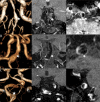Comparisons between cross-section and long-axis-section in the quantification of aneurysmal wall enhancement of fusiform intracranial aneurysms in identifying aneurysmal symptoms
- PMID: 35959406
- PMCID: PMC9361002
- DOI: 10.3389/fneur.2022.945526
Comparisons between cross-section and long-axis-section in the quantification of aneurysmal wall enhancement of fusiform intracranial aneurysms in identifying aneurysmal symptoms
Abstract
Background: To investigate the quantification of aneurysmal wall enhancement (AWE) in fusiform intracranial aneurysms (FIAs) and to compare AWE parameters based on different sections of FIAs in identifying aneurysm symptoms.
Methods: Consecutive patients were prospectively recruited from February 2017 to November 2019. Aneurysm-related symptoms were defined as sentinel headache and oculomotor nerve palsy. All patients underwent high resolution magnetic resonance imaging (HR-MRI) protocol, including both pre and post-contrast imaging. CRstalk (signal intensity of FIAs' wall divided by pituitary infundibulum) was evaluated both in the cross-section (CRstalk-cross) and the long-axis section (CRstalk-long) of FIAs. Aneurysm characteristics include the maximal diameter of the cross-section (D max), the maximal length of the long-axis section (L max), location, type, and mural thrombus. The performance of parameters for differentiating symptomatic and asymptomatic FIAs was obtained and compared by a receiver operating characteristic (ROC) curve.
Results: Forty-three FIAs were found in 43 patients. Eighteen (41.9%) patients who presented with aneurysmal symptoms were classified in the symptomatic group. In univariate analysis, male sex (P = 0.133), age (P = 0.013), FIAs type (P = 0.167), mural thrombus (P = 0.130), L max (P = 0.066), CRstalk-cross (P = 0.027), and CRstalk-long (P = 0.055) tended to be associated with aneurysmal symptoms. In the cross-section model of multivariate analysis, male (P = 0.038), age (P = 0.018), and CRstalk-cross (P = 0.048) were independently associated with aneurysmal symptoms. In the long-axis section model of multivariate analysis, male (P = 0.040), age (P = 0.010), CRstalk-long (P = 0.046), and L max (P = 0.019) were independently associated with aneurysmal symptoms. In the combination model of multivariate analysis, male (P = 0.027), age (P = 0.011), CRstalk-cross (P = 0.030), and L max (P = 0.020) were independently associated with aneurysmal symptoms. CRstalk-cross has the highest accuracy in predicting aneurysmal symptoms (AUC = 0.701). The combination of CRstalk-cross and L max exhibited the highest performance in discriminating symptomatic from asymptomatic FIAs (AUC = 0.780).
Conclusion: Aneurysmal wall enhancement is associated with symptomatic FIAs. CRstalk-cross and L max were independent risk factors for aneurysmal symptoms. The combination of these two factors may improve the predictive performance of aneurysmal symptoms and may also help to stratify the instability of FIAs in future studies.
Keywords: MRI; aneurysm wall enhancement; fusiform aneurysm; quantification; symptom.
Copyright © 2022 Peng, Liu, Niu, Feng, Zhang, He, Xia, Xu, Bai, Li, Sui and Liu.
Figures



Similar articles
-
Quantification of aneurysm wall enhancement in intracranial fusiform aneurysms and related predictors based on high-resolution magnetic resonance imaging: a validation study.Ther Adv Neurol Disord. 2022 Jul 12;15:17562864221105342. doi: 10.1177/17562864221105342. eCollection 2022. Ther Adv Neurol Disord. 2022. PMID: 35847373 Free PMC article.
-
Association Between Serum Homocysteine Concentration, Aneurysm Wall Inflammation, and Aneurysm Symptoms in Intracranial Fusiform Aneurysm.Acad Radiol. 2024 Jan;31(1):168-179. doi: 10.1016/j.acra.2023.04.027. Epub 2023 May 19. Acad Radiol. 2024. PMID: 37211477
-
Three-dimensional aneurysm wall enhancement in fusiform intracranial aneurysms is associated with aneurysmal symptoms.Front Neurosci. 2023 May 5;17:1171946. doi: 10.3389/fnins.2023.1171946. eCollection 2023. Front Neurosci. 2023. PMID: 37214386 Free PMC article.
-
Qualitative and quantitative wall enhancement associated with unstable intracranial aneurysms: a meta-analysis.Acta Radiol. 2023 May;64(5):1974-1984. doi: 10.1177/02841851221141238. Epub 2022 Dec 6. Acta Radiol. 2023. PMID: 36475308 Review.
-
Treatment of posterior circulation non-saccular aneurysms with flow diverters: a single-center experience and review of 56 patients.J Neurointerv Surg. 2017 May;9(5):471-481. doi: 10.1136/neurintsurg-2016-012781. Epub 2016 Nov 11. J Neurointerv Surg. 2017. PMID: 27836994 Free PMC article. Review.
Cited by
-
Systemic immune-inflammation index is associated with aneurysmal wall enhancement in unruptured intracranial fusiform aneurysms.Front Immunol. 2023 Jan 27;14:1106459. doi: 10.3389/fimmu.2023.1106459. eCollection 2023. Front Immunol. 2023. PMID: 36776878 Free PMC article.
-
Aneurysm wall enhancement, hemodynamics, and morphology of intracranial fusiform aneurysms.Front Aging Neurosci. 2023 Mar 13;15:1145542. doi: 10.3389/fnagi.2023.1145542. eCollection 2023. Front Aging Neurosci. 2023. PMID: 36993906 Free PMC article.
References
LinkOut - more resources
Full Text Sources

